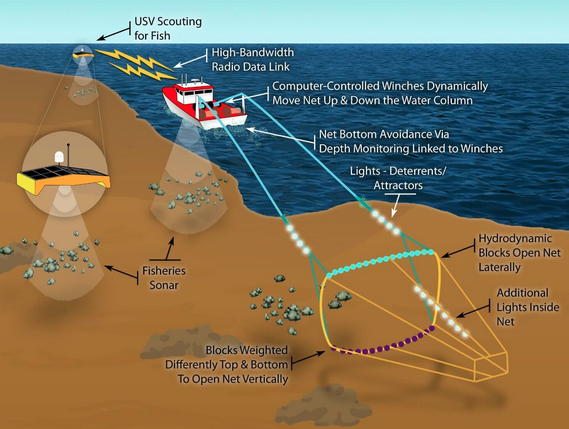- This Eufy robot vacuum has a built-in handheld vac - and just hit its lowest price
- I highly recommend this Lenovo laptop, and it's nearly 50% off
- Disney+ and Hulu now offer prizes, freebies, and other perks to keep you subscribed
- This new YouTube Shorts feature lets you circle to search videos more easily
- I replaced my Kindle with this E Ink tablet that runs Android - and don't regret it
Katchi: How sustainable fishing helps both fishers and the ocean

Now that the Cisco Global Problem Solver Challenge 2022 winners have been officially announced, you’ll want to learn more about each winning team and the story behind each innovation. The Cisco Global Problem Solver Challenge is an online competition that awards cash prizes to early-stage tech entrepreneurs solving the world’s toughest problems. Since 2017, the competition has awarded $3.25 million USD to 78 start-ups from 25 countries.
We are excited for you to learn more about the 2022 winning teams addressing some of the biggest challenges we face through technology-based solutions.
In response to the growing urgency to reverse climate change, we introduced five new Climate Impact and Regeneration prizes totaling $300,000 USD. These prizes recognize solutions that can reduce or remove greenhouse gas (GHG) from the environment or regenerate depleted ecosystems.
Meet Katchi, a rural Canadian company that won a $50,000 USD Climate Impact & Regeneration Runner-Up Prize. Both Katchi’s CEO and founder, Marc d’Entremont, and CFO, Angela “Angie” Greene’s, families and community are rooted in the fishing industry. They have watched over the years as increased regulation collides with existing fishing methods. Their solution works to achieve balance that helps both the fisher and the ocean.
What problem is your technology solution trying to solve?

Angie: With changes in the environment and an ever-increasing world population, healthy fish stocks are essential for achieving a sustainable future while still benefitting from one of the best forms of protein available — wild caught fish.
Fishers excel at knowing the sea and finding fish but are relying more on technology to target sustainable species. Katchi’s technology seeks to enhance fishing precision, while limiting the impact to both the environment and the fisher’s equipment. We believe that both goals are achievable through advancements using hydrodynamic engineering, sonar, sensors, and fish behavior research.
Can you explain how the solution works?
Marc: Our net system removes the need for heavy trawl doors, which are currently used to keep the net open. Water pressure works in tandem with hydrodynamic blocks to keep the net mouth open, while sensor data is used to automate the net’s tow cable winches, allowing the net to ‘fly’ close to the ocean floor without making contact. A contactless, deep-water net achieves many goals for both fishers and the environment. The main benefit is reducing fuel consumption and greenhouse gas emissions by 25 to 30 percent.
Katchi’s method reduces fuel consumption, damage to and loss of fishing gear, and bycatch (untargeted fish and marine species such as sea grasses and coral). It also increases vessel safety and allows fishers the potential to fish in areas that have been previously too difficult to fish. Our system uses technology to map and stream information to the vessel’s computer systems, which in turn controls the behavior and positioning of the net. The ability to position and automate a net will hopefully allow more flexibility in both ground fishing and mid-water trawling.
What is innovative about the way you are solving the issue? What sets your solution apart?
Angie: Our technology is designed to hug, not touch, the ocean floor. This allows fishers to continue to target sustainable ground fish species. Our net also allows fishers to follow schools of fish up and down the water column. Traditional trawl nets are not designed to do this. Our hope is that our system allows fishers to apply their knowledge with the new technology to fish different species in different locations more efficiently.

How will winning a prize in the Cisco Global Problem Solver Challenge help you advance your business?
Marc: The reputation and worldwide stage of Cisco and the Cisco Global Problem Solver Challenge is something that we are very grateful for. The prize money will be used to move faster towards our goal in our upcoming sea trials. We are completing a full-scale net this fall/winter, which has been previously tested at the flume tank at Memorial University in Newfoundland. The next round of tests involves mounting the system onto a large fishing vessel (the MV Lery Charles owned by Scotia Harvest Inc. – Digby Nova Scotia) and exposing it to the harsh conditions of a deep-water environment.
What advice do you have for other social entrepreneurs?
Angie: Be passionate and set the expectation that you will have to spend upwards of 100 hours talking to and meeting people before you gain traction. It took us a long time before we found like-minded people who loved our cause, and it took us even longer to find a niche group of specialists committed to our project to achieve results. This process was long, but key to building trust, interest, and relationships.
Stay tuned for more articles in our blog series, featuring interviews with every Cisco Global Problem Solver Challenge 2022 winning team!
Share:

